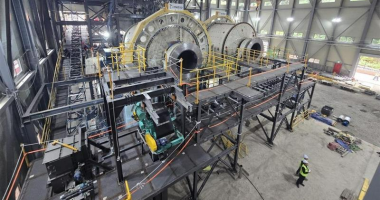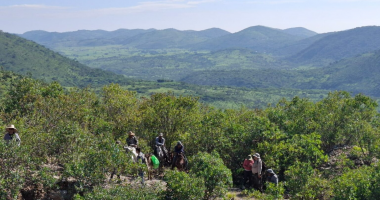- ASX-listed Iceni Gold’s (ASX:ICL) 14 Mile Well lies in the world-renowned Eastern Goldfields region of WA and is surrounded by successful gold-producing mines
- However, the 14 Mile Well area has never been explored before, largely due to split ownership among several prospectors and the presence of granite at the project
- Iceni Gold spent years consolidating tenements in the area to form the 14 Mile Well project, and the company has already completed 30,000 metres of drilling in the area
- Iceni’s share price has dipped as investors await drilling results, but Executive Chair Brian Rodan says this presents an opportunity for investors to get the most bang for their buck
- The company believes it holds some of the most prolific ground in Western Australia and, given the recent share price dip, is currently undervalued
- Shares in Iceni Gold last traded for 11 cents each on Wednesday, March 2
After spending years consolidating exploration tenements in the world-renowned Eastern Goldfields region of Western Australia, ASX-listed Iceni Gold (ICL) is now drilling for gold on untouched land.
The company’s flagship 14 Mile Well gold project lies in WA’s Yilgarn Craton, which hosts some of the most prolific gold mines on the planet. The Eastern Goldfields Superterrane, for example, has produced 130 million ounces of gold and is home to 17 world-class gold deposits.
Similarly, the Kurnalpi Terrane has produced over 40 million ounces of gold. Iceni’s 14 Mile Well project is part of this Kurnalpi Terrane.
Lying between Laverton and Leonora, 14 Mile Well is surrounded by a string of major gold-producing mines, including Gold Fields Australia’s Granny Smith and Wallaby mines and AngloGold Ashanti’s (AGG) Sunrise Dam mine. Together, these mines have produced over 16 million ounces of gold.
So, if Iceni Gold’s 14 Mile Well project lies in one of the most gold-rich regions of the world and is surrounded by successful projects, this begs the question: why has it never been explored before?
Outdated methods and split ownership
Iceni Gold Technical Director Dave Nixon said there were two main reasons the 14 Mile Well region has gone untouched despite all the success happening around it.
Firstly, the nature of the ground in the area means old-school geologists have typically been scared away by the presence of granites at 14 Mile Well.
“The reason it’s untouched is that there are a lot of granites there, and geologists have been trained to avoid the granites,” Mr Nixon told The Market Herald.
“That’s left it open. There’s the opportunity right there.”
Mr Nixon explained that while it’s conventional to avoid granite, this doesn’t mean a miner can’t find success in a granite-rich region.
In fact, he pointed to De Grey Mining’s (DEG) Hemi prospect as an example of successful gold mining in an area with lots of granites. De Grey’s major exploration success at Hemi saw the miner soar from a share price of just five cents to a peak of over $1.60 per share in less than 18 months.
Mr Nixon said contrary to how granites have typically been viewed by explorers over the years, these areas can actually aid the exploration process.
“Granites provide a source of heat and a source of metal that, as geologists, we know can deliver the goods.”
The other reason 14 Mile Well has gone unexplored is that up until Iceni Gold came along, ownership of the area was split between myriad prospectors over the past several decades.
Mr Nixon said these prospectors had been pulling up gold nuggets in the area from the surface — undoubtable evidence of the presence of gold.
However, Iceni Executive Chair Brian Rodan said because the land was split into so many small tenement holdings, this made the area unworkable for any major miners.
“Finally, after many years of consolidating tenements, it’s all under one package. It’s under one name. It’s under Iceni Gold,” Mr Rodan said.
“There’s no one exploring on a tenement package the size of ours in this region at all.”
He added that the company has already completed 30,000 metres of drilling in the area since listing on the ASX in April, with another 30,000 metres to come.
A backlog of results
Despite the potential of the area and Iceni’s confidence in its tenement package, the company’s share price has steadily declined over the past several months from a peak of around 30 cents per share to just 10 cents per share.
Mr Rodan put this down to one simple thing: “People are waiting on drilling results.”
He said keen investors always like to see good results, and Iceni is yet to publish the results from its 30,000 metres of drilling completed in the area. He said the company is still drilling, but it certainly had a backlog of results, which could explain the leaky share price.
However, Mr Rodan said at 10 cents per share, this, more than anything, presented an opportunity for investors to get the most bang for their buck.
“If we have any exploration success, which we would like to think we would, then there’s going to be a big jump. Maybe it’s a good opportunity for investors.”
Fundamentally, Iceni Gold believes it has the location, expertise, and structures to build a prominent gold mine in a prestigious mining region. At its current share price, the company believes it is undervalued — meaning it could present a shrewd opportunity for investors.
Shares in Iceni Gold last traded for 11 cents each on Wednesday, March 2. The company has a $24 million market cap.






